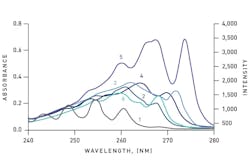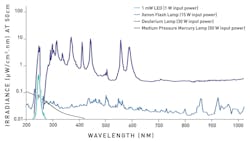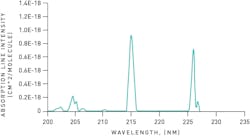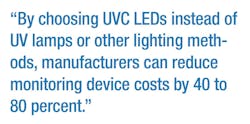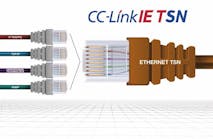With global environmental regulations growing tighter and ever more complex, industries and their regulators are seeking more efficient, cost-effective ways to monitor and reduce harmful emissions.
Traditional monitoring relies on lamp-based optical sensors, which are costly, bulky and require a considerable amount of electrical power. Optical sensors equipped with deep ultraviolet light emitting diodes (UVC LED) – which quickly identify harmful emissions from a wide range of compounds – are ideally suited to industry- or site-specific monitoring applications, and for good reason.
LEDs offer a long service life, reliability, low operating voltage and near monochromaticity, making it possible to develop portable, battery-run sensors that can be deployed individually or as a plant-wide network. Most important, by choosing UVC LEDs instead of UV lamps or other lighting methods, manufacturers can reduce monitoring device costs by 40 to 80 percent.
UVC-LED-equipped devices can replace traditional emissions-monitoring equipment at oil refineries, on cargo ships, within the auto industry and at power plants. In general, they are smaller, less expensive, consume less power and provide continuous emissions data in real time.
Monitoring emissions from refineries
Exposure to BTEX compounds – including benzene, toluene, ethylbenzene and xylenes – can cause respiratory problems and cancer. The compounds, formed during the production of refined petroleum products, are discharged into the environment with pipeline leaks or surface spills.
The U.S. Environmental Protection Agency estimates some 5 million Americans – not counting workplace exposures – face heightened cancer risks from benzene and 68 other carcinogens that may be released into the air by oil refineries. Environmental regulations have been tightened to ensure that these exposures are minimized.
Traditional BTEX detection involves gas chromatography and mass spectrometry. While reliable and sensitive, a highly skilled operator is needed, and field monitoring is limited because of the size and weight of the equipment. Further, analyte desorption and pre-concentration requirements are time-consuming and provide no data on spatial and temporal gas concentration variations.
Ultraviolet – visible (UV-Vis) spectroscopic technologies are an attractive alternative because BTEX compounds, which show strong UV absorption between 240-nanometer (nm) and 280-nm (see Figure 1) wavelengths can quickly be identified and quantified after deconvolution of the spectrum.
Traditional UV-Vis detection devices employ broadband emitters, such as deuterium lamps, as their primary light source and monochromators for wavelength selection. While the lamps provide relatively high light output in the applicable wavelengths (see Figure 2), they require a stable (and expensive) power supply to maintain their performance. They can also be bulky and consume substantial electrical power – 20 to 30 watts (W), and may take up to 30 minutes to warm up.
As such, oil refineries often choose photometric sensors equipped with UVC LEDs. These devices use a simple photodiode and exhibit low noise and linearity of measurement at lower, more precise detection levels. The BTEX detection limit of a UVC-LED-based detector is 10 times lower than instruments using a deuterium lamp and monochromator.
Further, the LED’s low power consumption facilitated the development of battery-operated, portable instruments that can be located throughout the plant, delivering data in real time and protecting the plant’s workforce and the environment.
Monitoring emissions from ships
In the global economy, 90 percent of trade involves cargo shipping that depends on fuel with a sulfur content several thousand times higher than the fuel used in diesel-powered automobiles. These ships do not have exhaust abatement technologies such as particulate filters, resulting in significant sulfur dioxide (SOx) and nitrogen oxide (NOx) emissions.
To reduce emissions, the International Maritime Organization has established limits on marine fuel sulfur content and defined emission control areas (ECA) – locations close to shore in which airborne emissions must be minimized. To meet the restrictions, ship owners must either switch to more expensive, low-sulfur fuels when in an ECA or install gas scrubbers to reduce SOx emissions. Their compliance is monitored using sensors based on absorption spectroscopy. If scrubbers are installed, a system must be capable of measuring emissions down to the equivalent of 0.1 percent sulfur. If fuel switching is implemented, the system must be able to monitor emissions before and after entering an ECA.
Existing UVC LED absorption spectroscopy devices operating at the 230-nm and 280-nm wavelengths can ensure NOx and SOx emission compliance. Unlike devices that use traditional UV lamps as a light source, UVC-LED-based devices offer shipping companies greater light intensity and stability, low-voltage operation, longer service life and a lower cost of ownership (see Figure 3).
Monitoring NOx emissions from cars
Tests conducted by the International Center for Clean Transportation in 2016 found that, on average, automobile NOx emissions measured under actual driving conditions (as opposed to the automaker’s lab) were six times higher than the regulatory limit – regardless of vehicle type, region (U.S. and European Union – E.U.), manufacturer or after-treatment technology.
New E.U. NOx regulations under consideration will require manufacturers to test cars with attachable portable emissions measurement systems (PEMS) that employ non-dispersive infrared (NDIR) spectroscopy. However, NDIR sensor accuracy is affected by moisture and carbon dioxide in the sample gas. Non-dispersive UV (NDUV) spectroscopy, on the other hand, is ideal for measuring PEMS’s smaller NOx concentrations.
However, NDUV sensors, which use an electrodeless discharge lamp as the light source, can be expensive, require frequent lamp replacements and suffer from performance limitations, such as drift. A 230-nm wavelength LED would facilitate a more direct NOx measurement (see Figure 4), last longer and lower NDUV system costs by 40 to 80 percent.
LED-based devices could also play a role in the future when industry analysts predict cars will have built-in NOx sensors for real-time exhaust monitoring. These sensors will need to deliver instantaneous NOx readings, have limited cross sensitivity to other exhaust gases like SOx and withstand severe exhaust system temperatures.
Electrochemical gas sensors have been used in similar applications, but they have limited service life and suffer from cross-response issues such as humidity. With LED-based optical devices, optical fibers can be used to isolate the sensor from the harsh environment of the tailpipe, and the sensors can quickly detect and respond to rapid NOx concentration changes as they occur – for example, when the driver shifts gears and quickly changes the engine load.
Monitoring ozone generation
Emissions that create ozone come from different sources including cars, trucks, refineries, power plants, factories, and oil and gas wells. Even low-level exposure to ozone can reduce lung function and aggravate preexisting respiratory conditions. However, ozone can be beneficial when used in industrial processes including semiconductor cleaning and water purification. So accurately monitoring ozone levels is critical.
Quantifying the amount of ozone in the air is currently accomplished via UV absorption spectroscopy at 255 nm. The process involves sequential measurements of the sample gas and a zero gas (gas with no ozone) fed alternatively through a chamber. Therefore, the intensity of the light source must remain stable between the two measurements to ensure high accuracy. UVC LEDs offer a light source stability of 0.002 percent, which is better than a traditional mercury lamp’s range of 5 to 20 percent. As a result, manufacturers are migrating from mercury-lamp-based ozone monitors to UVC-LED-based versions.
Conclusion
With regulations across environmental monitoring markets becoming increasingly complex, UVC LEDs offer original equipment manufacturers design flexibility, high light output and stability, and a long service life. By choosing UVC LEDs instead of UV lamps, manufacturers can reduce device costs by 40 to 80 percent. Next generation sensors are emerging as more manufacturers understand the benefits of this solid-state, environmentally friendly UVC source.
Hari Venugopalan is director of product management for Crystal IS. He has more than 10 years of experience in visible and UV LEDs.
Crystal IS
www.cisuvc.com
